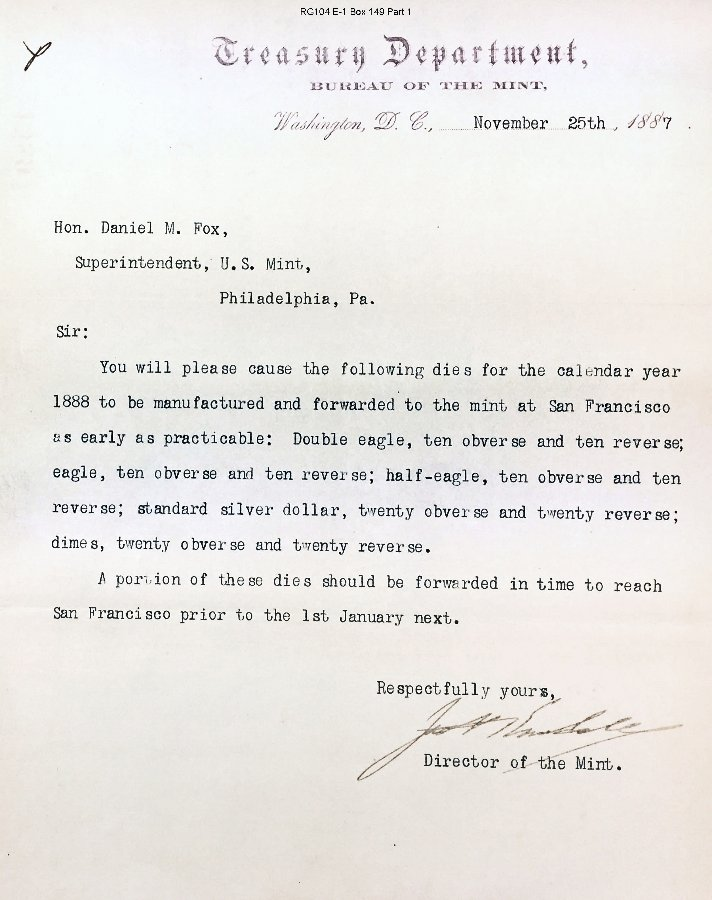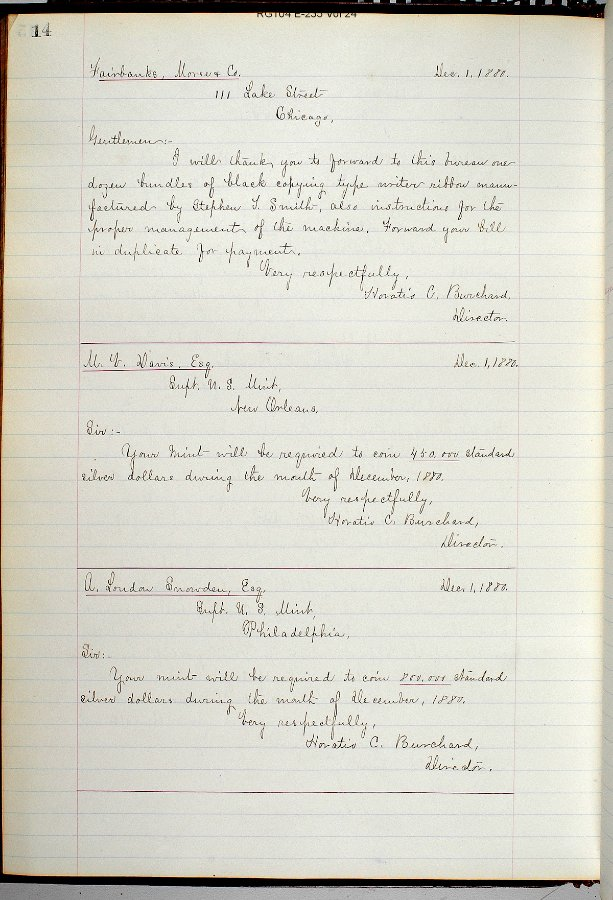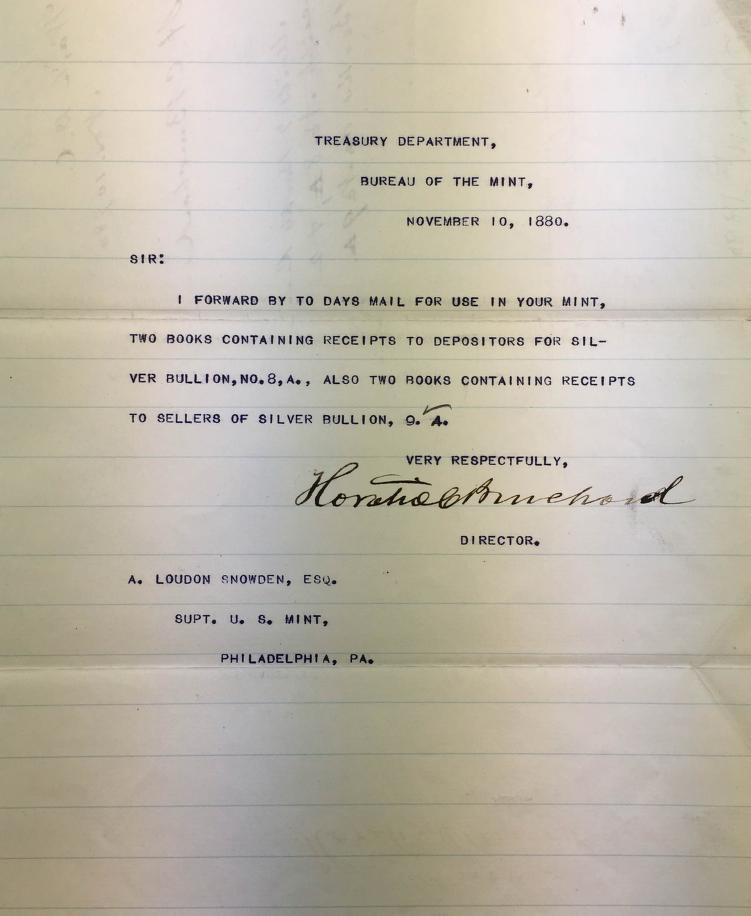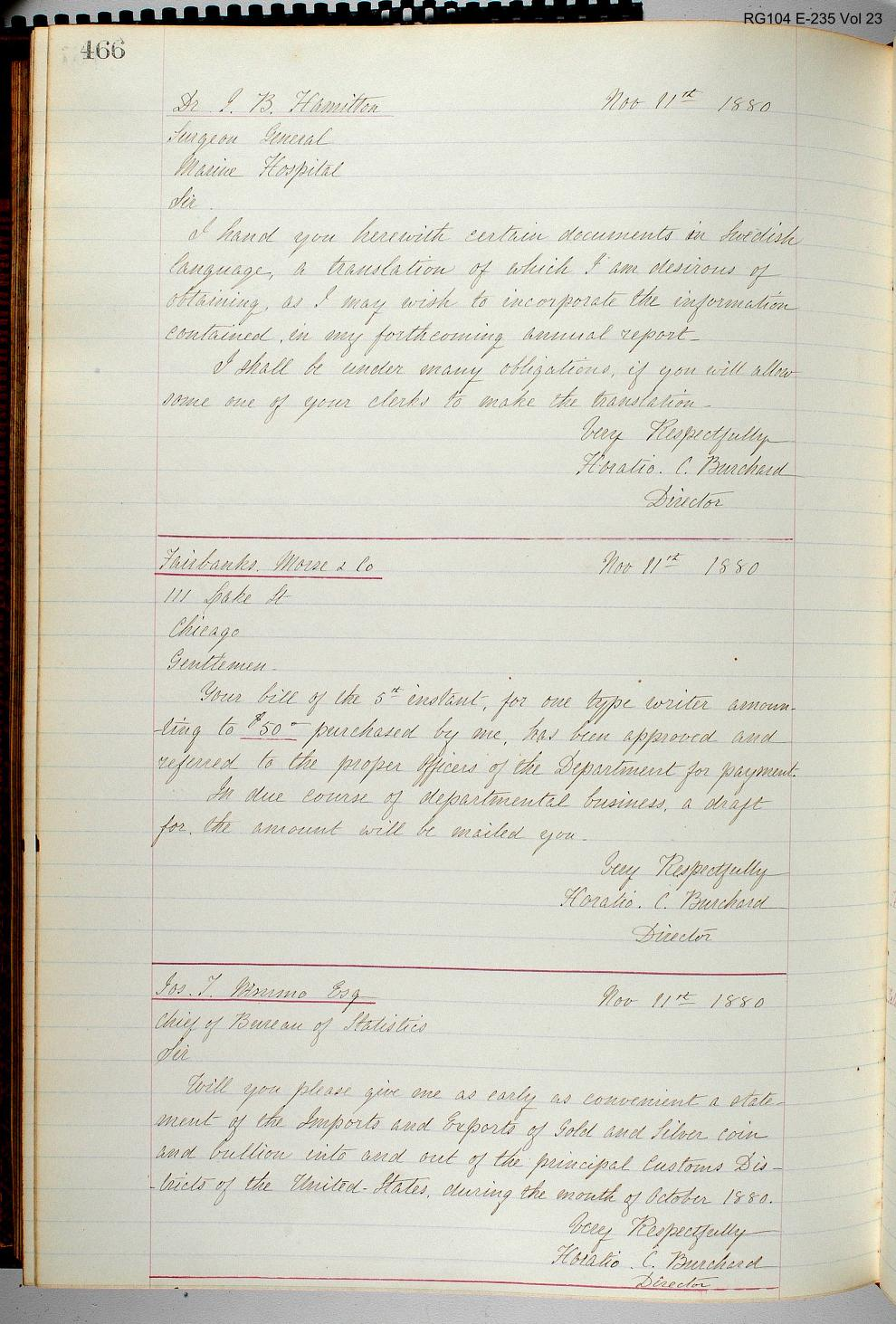The Mint Director's first Type-Writer
As I hinted in a previous post, I found myself looking into when the Mint Director's office first got a typewriter. I blame the NNP and RogerB for this, as the repository of Mint paperwork there is rather vast and is likely to make you think you can find out anything if you spend enough time careening down that rabbit hole. What started this was a typed order for dies to be sent to San Francisco for 1888.

I'm thinking to myself that's pretty early in typewriter history and wondered when the Mint Director's office first got one, what kind, and what help the archives would be in figuring this out. Of course, I didn't think it to myself, I thought it out loud, by which I mean I posted it to the thread on VAMWorld where the letter appeared. Shortly thereafter, Roger posted this from December 1, 1880, from the Fair Copy Book.

December 1, 1880
Fairbanks, Morse & Co.
111 Lake Street
ChicagoGentlemen:
I will thank you to forward to this bureau one dozen bundles of black copying typewriter ribbon manufactured by Stephen T. Smith, also instructions for the proper management of the machine. Forward your bill in duplicate for payment.
Very respectfully,
Horatio C. Burchard,
Director
1880 is way earlier than 1887, so I started spelunking through the General Correspondence box looking for more clues. Lo an behold, November 1880 has a few typed pages in the box, no more than 1 per day, including this, the earliest typed page in the box:

So it was back to the Fair Copy Book of letters from the Mint Director. Fortunately, the front of the book contains an index making it possible to go to letters to a specific recipient. Since Burchard wanted ribbons and maintenance instructions from Fairbanks, Morse & Co. (FM&C), perhaps that's where he got the typewriter. The lone entry for the rest of 1880 was on November 11, the day after the above letter was typed.

Your bill of the 5th instant, for one type writer amounting to $50 purchased by me, has been approved and referred to the proper officers of the Department for payment.
In due course of departmental business, a draft for the amount will be mailed you.Very Respectfully
Horatio C. Burchard
Director
So apparently he liked the typewriter enough to pay for it. I looked in vain for the bill to see if it showed the make and model, but it wasn't to be found. Nevertheless, there were other ways to investigate this. I started looking into typewriters that were made around then and came up with the Sholes & Glidden typewriter, which was mass produced in 1873 by Remington as the Remington No. 1. It only had upper case letters. Remington outsourced their marketing to FM&C, a scale manufacturer which was by that time a rather diverse industrial supplier, in 1878. Remington also produced a typewriter with both upper and lower case, using a shift key (rather than a second set of keys), the Remington 2, and another upper-case only called the Remington Perfected 4, seemingly a replacement for the Remington 1, which received accolades at the Paris Exposition in 1878.

The picture above is from a rather impressive website of an antique typewriter collector, https://www.antiquetypewriters.com, as is some of the information about it. I contacted the collector and sent him the above picture of the November 10, 1880 page to see if the typeface indicated which model produced it, but he said that there were multiple fonts in production for multiple typewriters, so the model couldn't be determined, but he agreed that it was quite possibly the Remington Perfected 4, maybe the Remington 1. He was rather excited to see the letter, and was impressed that it still existed.
By 1897, all correspondence at the mint was typed. One year earlier, Underwood successfully launched "visible" typewriters, where the type bars struck the front of the platen like those of us who have used a typewriter are used to seeing. Before that, the type struck the underside of the platen so that you were typing blind.
Keeper of the VAM Catalog • Professional Coin Imaging • Prime Number Set • World Coins in Early America • British Trade Dollars • Variety Attribution
Comments
Very cool find.
Looking for Top Pop Mercury Dime Varieties & High Grade Mercury Dime Toners.
Interesting indeed.... I wonder what the archives of the future will look like... or should I say 'present'...all digitally stored I would assume - emails etc.. The search function will be faster though...Cheers, RickO
The day writing skills went down the drain!!
Outstanding research John! Well done
Latin American Collection
Excellent research.
I seem to recall there being a Fairbanks St. in Chicago. No idea if there is a connection.
Interesting to me, a two-fingered typist, that the keyboard configuration has remained unchanged. Must tell us something.
Nice that's cool
I read somewhere that the person who invented the first typewriter had found that because it took a certain amount of time for each letter arm to come up and strike the paper and then go back down, the machine jammed if somebody typed too fast. Therefore, he devised the QWERTY keyboard to slow the typists down, and other makers copied him.
The day writing skills went down the drain!!
probably not, that probably happened much later as a "slow burn" once the Telephone became a staple in every American home. I know my Mother still corresponded by mail as late as the mid-1960's and we wrote back-and-forth as late as 1978 when I was in the USN. it's peculiar that writing has had a modern resurgence with the Invention and Mass Marketing of the PC. I communicate in this fashion every day. now, strangely, many of the younger generation prefer to text rather than talk, so all is not lost.
I realize it isn't the same as 200 years ago, but we still communicate quite a bit with the written word and comprehensive thought. I have always been amazed by the fact that the Typewriter has faded away but the keyboard it was structured around has remained an integral part of Modern Society.
I've heard this, but it seems not to be the case. The QWERTY layout was finalized by Remington in 1878 after much experimentation. The problem was that the action of the machine was sufficiently slow that adjacent keys typed rapidly were prone to jamming. This would indeed be prevented by slowing typists down, but such a slow-down would only be temporary, as an initially slower layout would become a fast one as people learned it, requiring the layout to be randomized every so often. Some experiments were done to move commonly jammed keys away from each other. Supposedly, telegraph operators were also involved in an effort to keep similarly coded letters away from each other. As Remington basically had a monopoly on typewriters as they were becoming popular, other vendors not copying that layout would have produced slower typewriters, simply because nobody would have learned that layout yet.
Keeper of the VAM Catalog • Professional Coin Imaging • Prime Number Set • World Coins in Early America • British Trade Dollars • Variety Attribution
One wonders why the keyboard I'm typing on now retains the same pattern. I suppose it's still due to the fact that so many were trained using this layout. We may see a leap someday to a different layout if there is a more efficient one.
I read somewhere that the person who invented the first typewriter..........................
I think it might be hard to nail down "one person" who invented the Typewriter. the idea of it is actually pretty old and from what I've read people just improved on what had come before till we have the modern machine.
Wow! So cool
Instagram - numismatistkenny
My Numismatics with Kenny Blog Page Best viewed on a laptop or monitor.
ANA Life Member & Volunteer District Representative
2019 ANA Young Numismatist of the Year
Doing my best to introduce Young Numismatists and Young Adults into the hobby.
Excellent research ... great read! Thanks @messydesk
“We are only their care-takers,” he posed, “if we take good care of them, then centuries from now they may still be here … ”
Todd - BHNC #242
I have an about 100 year old typewriter upstairs that I keep as a memory. My then very elderly neighbour gave it to me about 20 years ago. It has to have the ribbon re-inked manually. I have typed on it, but compared to modern keyboards, older typewriters required a lot of acquired finger strength to operate.
My dad was a typewriter repairman in the 80s and that’s what I wanted to be when I grew up. Fortunately he had the foresight to switch to computers and retired an IT pro a few years ago. Thanks for the thread. Really interesting and took me back to my childhood just a few hrs before Father’s Day.
I wonder when the mint got their first roll of correction tape?
Great transactions with oih82w8, JasonGaming, Moose1913.